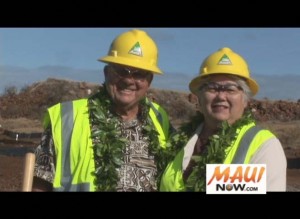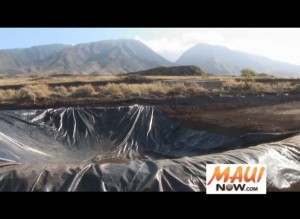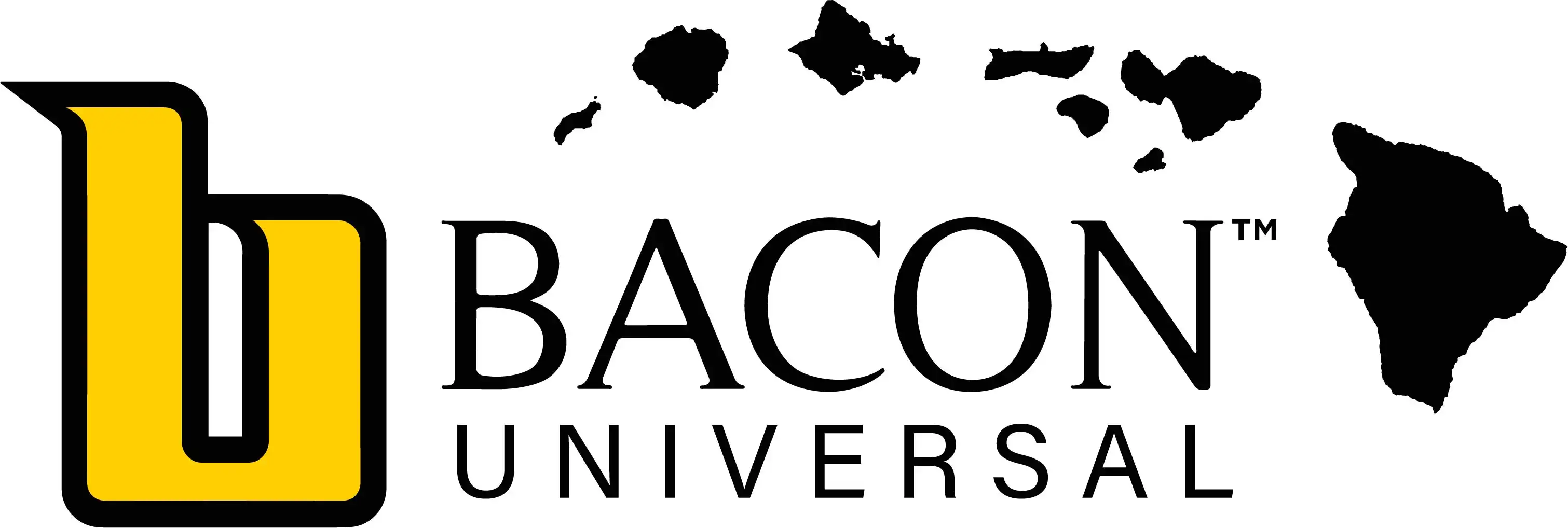VIDEO: Lahaina Watershed Flood Control Breaks Ground After 30 Years of Planning
By Wendy Osher
[youtube]http://www.youtube.com/watch?v=QtIfcpkJbgI[/youtube]
The county broke ground today on the long awaited Lahaina Watershed Flood Control Project. The project is designed to divert floodwater from the heavily populated Lahainaluna, Puamana and the surrounding area. Maui Mayor Charmaine Tavares said that after 30 years of planning, a half a century of discussion, she is pleased to see the first phase finally get underway.

David "Buddy" Nobriga and Maui Mayor Charmaine Tavares join in breaking ground on the long-awaited Lahaina Watershed Flood Control Project. Photo by Wendy Osher.
“I can’t even begin to imagine what the impact of this is going to be and the beneficial part of it for Lahaina Town and for our near-shore waters. Several years ago, we had a flood situation in Lahaina where, as a council member, I saw hundreds and hundreds of claims for flood damage coming before the council because of the inadequate drainage systems to address water coming through Lahaina town,†said Tavares.
County officials say Phase 1 of the five-phase project includes the installation of the ocean outlet at Waianukole consisting of two culverts, a sediment basin and a drainage channel up to Hoikeike Place. Despite the apparent need for flood control, the project encountered a number of obstacles along the way. Senator Roz Baker of West Maui recalled discussion over land use, project alignment and drainage points.
“I remember having meetings when I first started to run for office in 1986 with the folks in Puamana who were very concerned about the initial alignment, and what this project was going to look like. But ultimately (they) became very supportive,†said Baker.
Delays were also encountered with access rights and property ownership, according to David “Buddy†Nobriga, who has been with the project from its start, finally retiring two years ago, after 52 years with the West Maui Soil and Water Conservation District.
“The first EIS they made, they dragged their feet so long. We need cosponsors to take care of land acquisition, we’re only volunteers. We can’t tell somebody to condemn their land, but the county can,†said Nobriga.

The Lahaina Flood Control project is designed to divert floodwater from the heavily populated Lahainaluna, Puamana and the surrounding area. Photo by Wendy Osher.
Nobriga said the threat of flooding and runoff impacts became compounded when the sugar industry stopped cultivation above Lahaina Town.
“We live here, we took sugar for granted, and we never realized, (or the people didn’t realize) how much sugar prevented them from getting flooded…When it rained, they (Pioneer Mill) made sure they flumed all the water they had back to this side…away from the homes,†said Nobriba.
“They had two dirt dams from Lahainaluna Road out to prevent water from coming down…we bring all the water down to the old punawai down at Waihee Village.â€
The project took several decades of planning, design and preparation, officially beginning in 1980 by the Federal Soil Conservation Service (the predecessor of the Natural Resources Conservation Service), and the County of Maui.
“As years go by, we forget how hard it was to get it started…every time we had a public meeting, we had to go back to the drawing board again and do something else,†said Nobriga.
Tavares said that instead of waiting for dams and levy collapses government could save billions of dollars by taking preventative measures.
“It’s harder to sell prevention than it is to sell recovery…It is so difficult to convince people about things that will be preventive than it is to react to an emergency. Everybody jumps (during an emergency)…when we could have prevented it by diligently and expeditiously moving this project forward,†said Tavares.
The contract for Phase I was awarded to Kiewit Construction in a $6.3 million contract that was partly paid for with federal funds. When complete, the project will protect over 340 acres both urban and agriculture from flood damage, reducing flood born sediment and protect Lahaina’s coral reefs.









